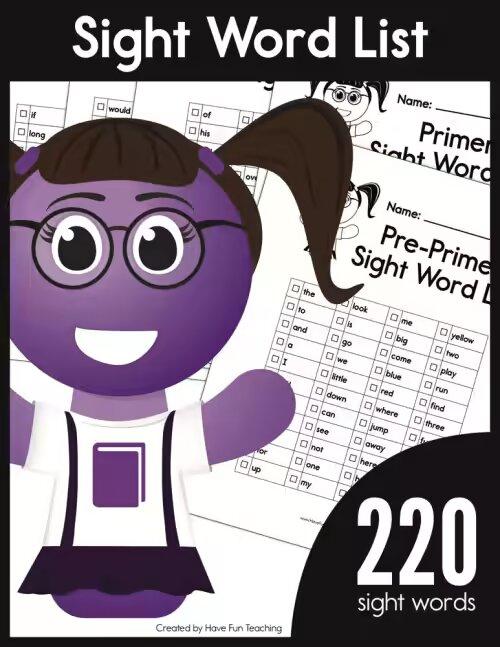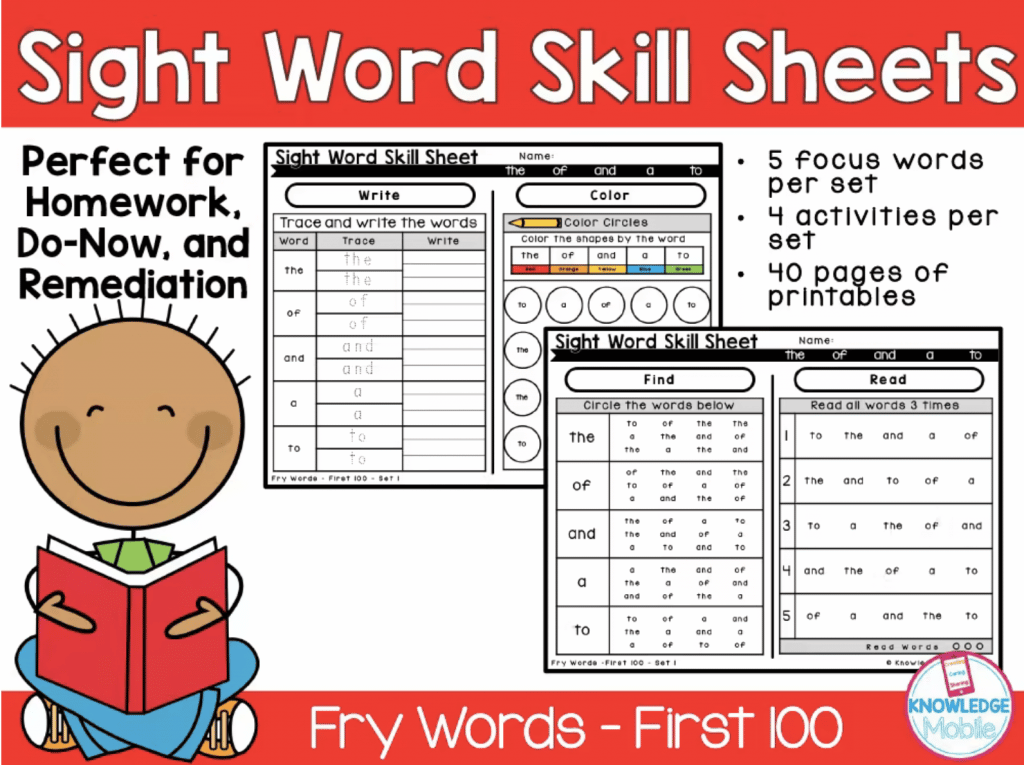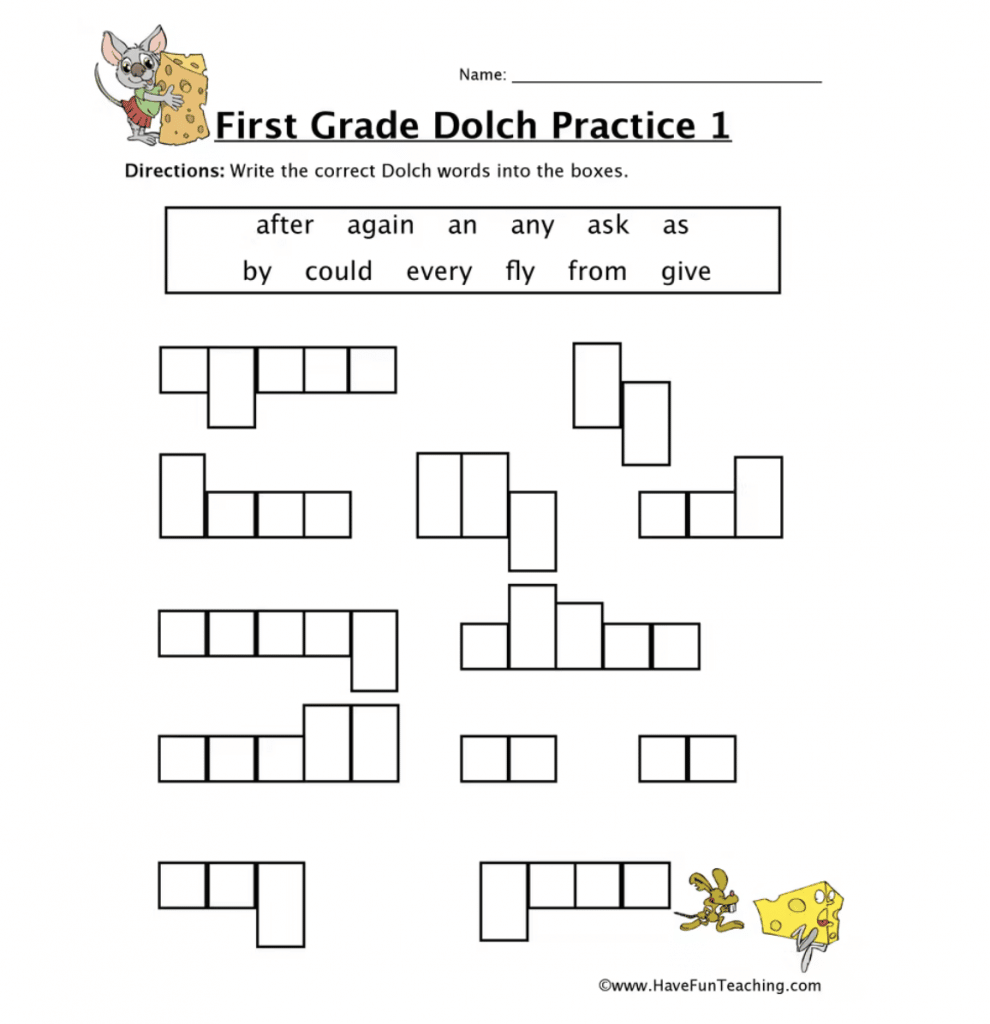There is so much more to reading than memorizing a first grade sight word list, but that doesn’t mean memorizing sight words themselves aren’t important! Because sight words aren’t easily sounded out, we want our children to recognize them quickly. Their ability to recognize these words is a big part of reading fluency.
Table of Contents
- How Many Sight Words Should My 1st Grader Know?
- 1st Grade Dolch Sight Words
- Fry Sight Words for Frist Grade
- First Grade Sight Word Resources and Activities
- Importance of Learning Sight Words for Fluent Reading in First Grade
- Ideas for Implementing Sight Words in First Grade
- What Should a First Grader Be Able To Read?
- Check Out These Additional 1st Grade Resources
How Many Sight Words Should My 1st Grader Know?
Typically, you want your 1st grader to consistently recognize about 100 sight words. Of course, the more the merrier! While rote memorization is a lower rigor task, when it comes to reading—memorizing these words is key. They play a significant role in basic reading and are part of the early literacy foundation essential to long-term reading success.
In kindergarten, your child will learn and remember about 20 sight words. These include words like “you” and “the.” As they work through 1st grade, you’ll see the sight words become a little more complex. Words like “would” and “which,” for example, will be part of their lessons. The more quickly students can recognize and recall these words, the more efficiently they’ll be able to read.
1st Grade Dolch Sight Words
Dolch Sight Words are a group of English words. Kids should know these words right away when they see them. They don’t need to sound them out. Edward William Dolch, a scholar, made this list. He published it in his book, “Problems in Reading,” in 1948.
Dolch created this list by studying kids’ books from his time. That’s why people often call it “Dolch’s Sight Word List.”
There are 220 words on this list. They’re called “service words.” Kids need to know these words to read English well. Teachers usually start teaching these words in kindergarten and first grade. Kids keep practicing these words as they move up in school. The list has simple, everyday words like “the,” “is,” and “it.”
Dolch also made a list of 95 common nouns. Kids should know these nouns right away, too. Some examples are “cat,” “man,” and “day.”
But remember, the Dolch list isn’t everything. It’s a helpful tool for teaching kids to read. But to really know the English language, kids need to learn more words than just the ones on the Dolch list.
| after | again | an | any | as |
| ask | by | could | every | fly |
| from | give | going | had | has |
| her | him | his | how | just |
| know | let | live | may | of |
| old | once | open | over | put |
| round | some | stop | take | thank |
| them | then | think | walk | were |
| when |
Fry Sight Words for Frist Grade
Fry Sight Words are another group of English words. Kids should know them quickly when they see them. A man named Dr. Edward B. Fry made this list. His list is bigger than dolch sight words list and newer than Dolch’s list.
The Fry Sight Words list has 1,000 words. These words are split into ten groups. The first group has the most common words. The second group has the next most common, and so on.
Teachers often start teaching these words in kindergarten. They continue teaching them through third grade. But, kids keep practicing these words even after third grade.
The list has simple words like “and,” “the,” and “you.” These words are common in English, so kids see them a lot when they read.
Just like the Dolch list, the Fry list is helpful. But it’s not everything. Kids need to learn other words too. So, while the Fry list is a good start, kids should also learn new words as they read more books.
| the | of | and | a | to |
| in | is | you | that | it |
| he | was | for | on | are |
| as | with | his | they | I |
| at | be | this | have | from |
| or | one | had | by | word |
| but | not | what | all | were |
| we | when | your | can | said |
| there | use | an | each | which |
| she | do | how | their | if |
| will | up | other | about | out |
| many | then | them | these | so |
| some | her | would | make | like |
| him | into | time | has | look |
| two | more | write | go | see |
| number | no | way | could | people |
| my | than | first | water | been |
| call | who | oil | its | now |
| find | long | down | day | did |
| get | come | made | may | part |
First Grade Sight Word Resources and Activities
Building a strong vocabulary foundation is crucial for first graders as they continue to develop their reading skills. One way to do this is through sight words, which are common words that young readers should ideally recognize instantly. This instant recognition helps children read more smoothly and quickly, leading to better comprehension. Sight words like those on the Dolch and Fry lists are an integral part of this learning process.
To support this critical learning stage, we’ve compiled these valuable resources and engaging activities. These tools and activities are specially designed to help first graders master sight words. They transform learning into a fun and interactive experience, making sight word practice enjoyable and effective. From printable flashcards to exciting sight word games, each of these resources will contribute significantly to your child’s or student’s journey to becoming a proficient reader. Dive in and explore these unique learning aids for first grade sight words.
Because sight words are used with such frequency, you can easily turn any outing into a sight word “I Spy” game. When you’re at the store, keep an eye out for sight words and quiz your little one. Challenge them to find a certain number of sight words “in the wild” and keep track of how many they can find. A little bit of practice here and there reinforces learning and builds those essential reading skills.
At school or home, there are quieter activities that can help with the memorization of the words above. In partnership with Teach Simple, whose marketplace is full of educational materials created by actual teachers (plus 50% of all revenues go to them), I’ve gathered a few tried-and-true sight word practice activities below. Have a look!
Sight Word Skill Sheets – Fry Words – First 100
This set features 5 focus words that are perfect for introducing one word a day, or completing on set of activities a day. Students go through the four activities to learn more about the words.
Students will:
1. Write and trace the words
2. Color the shapes by word
3. Find and circle the focus sight words
4. Read all of the words three times for repetition
Sight Words Find and Color
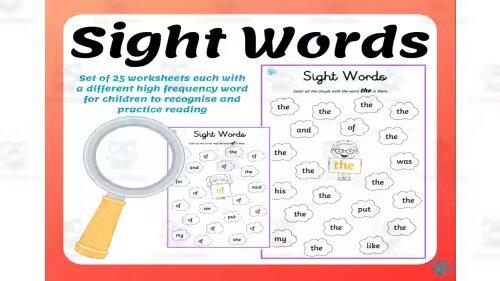
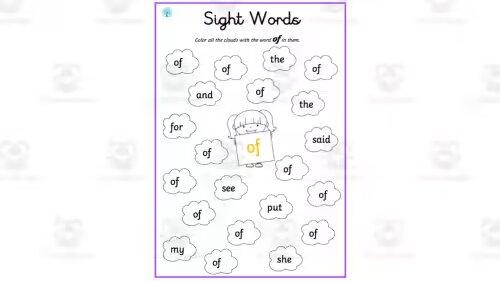
These worksheets focus on different high frequency sight words to support children with with reading and recognizing words. Children can pick out the given word and only color the clouds with that word in it.
Sight Word Hide and Seek
Print or write out sight words on notecards and hide them around your home or classroom. Have students seek them and yell the word out loud when found. This is fun and if made into a race helps raise the affective filter to get students engaged!
Sight Word Trace Activity
Tracing is an awesome tool to support handwriting, practice fine motor skills, and reinforce memorization of sight words. This tracing activity focuses on a defined set of sight words in the Fry list.
| 1st Grade Fry Sight Words | Where to Get Them |
|---|---|
| Fry Words 1-10 | Download Here |
| Fry Words 11-20 | Download Here |
| Fry Words 21-30 | Download Here |
| Fry Words 31-40 | Download Here |
| Fry Words 41-50 | Download Here |
| Fry Words 51-60 | Download Here |
| Fry Words 61-70 | Download Here |
| Fry Words 71-80 | Download Here |
| Fry Words 81-190 | Download Here |
| Fry Words 91-100 | Download Here |
First Grade Sight Words Crossword
Have students learn about crosswords and sight words in one worksheet. This is great practice for identifying and writing important sight words and understanding the fundamentals of a crossword puzzle.
| 1st Grade Dolche Sight Words | Where to Get Them |
|---|---|
| Sight Words A-G | Download Here |
| Sight Words H-M | Download Here |
| Sight Words O-S | Download Here |
| Sight Words T-W | Download Here |
Importance of Learning Sight Words for Fluent Reading in First Grade
Enhances Reading Speed and Comprehension
Learning sight words is crucial for first graders, as it significantly improves their reading speed and comprehension. These common words appear frequently in texts, so recognizing them without having to decode each letter allows first grade students to read more efficiently. Some examples of first grade sight words include:
- the
- and
- you
- that
- was
By knowing these words by sight, first graders can focus on understanding the meaning behind sentences instead of getting stuck on individual words.
Builds Confidence in Reading
Mastering sight words gives first graders a confidence boost in their reading abilities. When they can easily recognize sight words and read these common words, they feel more capable and eager to tackle new texts and materials. This enthusiasm for reading sets them up for continued success throughout their education.
Supports Writing Skills Development
Knowing sight words doesn’t just benefit reading – it also helps first graders develop their writing skills. Since these words occur frequently in written compositions, being able to recall and use them with ease allows students to write more fluently. For example, if a student knows the sight word “and,” they can quickly incorporate it into a sentence like:
I have a dog and a cat.
This proficiency with sight words enables first graders to focus on crafting meaningful sentences rather than struggling with basic vocabulary.
Fosters a Strong Foundation for Future Learning
Acquiring proficiency in sight words during the first grade lays the groundwork for continued academic success. As students move through higher grades, they’ll encounter increasingly complex concepts and vocabulary. Having already mastered common sight words allows them to concentrate on learning new material without getting bogged down by basic reading challenges.
So how many sight words should a first grader know? While there’s no set number, most educators agree that children should learn around 100 high-frequency words by the end of first grade.
Ideas for Implementing Sight Words in First Grade
Sight Words Worksheets for Reinforcement
To enhance your child’s learning experience, we’ve compiled a collection of sight words worksheets specifically designed for first graders. These worksheets focus on reinforcing word recognition and comprehension skills through various activities, such as:
- Word tracing exercises.
- Fill-in-the-blank sentences.
- Word search puzzles.
- Sight word bingo games.
By using these interactive worksheets, children can practice their sight words while having fun and engaging in hands-on learning experiences.
Creating an Engaging Word Wall with Printable Lists
A great way to make practicing first grade sight words enjoyable is by creating an engaging word wall using our printable lists. Not only does this provide a visual reminder of all the words they need to learn, but it also fosters a fun and interactive environment for children to practice their new vocabulary skills.
Here are some tips on how to create an effective word wall:
- Print out our comprehensive list of first grade sight words.
- Cut out each individual word and laminate them for durability.
- Arrange the laminated words on a designated wall or bulletin board in alphabetical order or by theme (e.g., colors, numbers).
- Encourage your child to interact with the word wall daily by reading aloud, spelling, or using the words in sentences.
Reading Races
Reading races are a fantastic way to engage first graders in sight word activities. This activity encourages friendly competition and improves reading skills simultaneously. Here’s how to set up a reading race:
- Choose a book or prepare papers with sentences containing first grade sight words.
- Divide the children into pairs or small groups.
- Assign specific sight words for each group to find and read.
- Start the race, and watch as the kids eagerly search for their assigned words.
This activity not only helps young readers practice their sight words but also promotes teamwork and collaboration.
Storytelling with Sight Words
Boost your child’s reading and creative skills by encouraging them to create their own stories using sight word flashcards. This activity is both fun and educational, as it allows children to:
- Practice recognizing and reading first grade sight words
- Develop their storytelling abilities
- Enhance their imagination and creativity
To start, give your child a set of sight word flashcards, then let them arrange the cards in any order they like to create an original story.
Sight Word Space Hop
Turn learning into a fun physical activity with this engaging game that combines movement with reading practice:
- Place sight word cards on the floor, spaced out enough for children to jump between them.
- Have the children take turns jumping from one card to another while reading the words aloud.
- Encourage kids to move quickly but accurately, ensuring they correctly read each word before hopping onto the next card.
This energetic activity not only reinforces essential reading skills but also helps burn off some energy!
Letter Hunt
Reinforce first graders’ recognition of essential sight words through this exciting letter hunt:
- Provide kids with a list of first grade sight words.
- Hand out books or magazines for them to search through.
- Instruct children to find and circle the letters that make up each sight word in their assigned material.
Incorporating Sight Words into Daily Routines
One of the most effective ways to help first graders learn sight words is by incorporating them into daily conversations. This provides context and frequency that can lead to better understanding and retention. Here are some tips for introducing new words:
- Use the word in a sentence during casual conversations
- Explain the meaning of the word if necessary
- Encourage your child to use the word in their own sentences
By using these simple techniques, you’ll be creating an environment where learning sight words becomes a natural part of everyday life.
What Should a First Grader Be Able To Read?
By first grade, your child should be able to read relatively independently when given age-appropriate books. They will be able to use their knowledge of sight words, ability to sound out words, and their understanding of basic punctuation to discern meaning from a text.
They should also be able to tell if a text is fiction or nonfiction. Even without images to support their reading, they should be able to make it through an appropriate text and summarize the key events.
By the end of first grade, you should have a relatively independent reader. Your little one will have basic grammar skills that they will use to navigate the ideas developed in a text. The true test of their abilities as early readers will be seen in the balance of reading the text and comprehending what is said in the story.
Practice reading sight words with your child every day in context. If they know their sight words, they’ll be able to read simple books that are written for first graders without help. So choose books about their favorite topics—dinosaurs or ballet or mermaids—and take turns reading them together!
At the end of the day, you want to make sure your reader is getting tons of chances to practice with their sight words. Whether you are seeking them when you’re on a trip to the store, practicing with grade sight words list or word worksheets, or just revisiting a first grade sight word list posted on the fridge, those little bits of practice will do wonders!
Check Out These Additional 1st Grade Resources
About the Author
Ali Pierce has been a proud public school teacher for nearly a decade. An English teacher by day, Ali works with educators throughout K-12 in a variety of coaching and support roles. A proud Wildcat, Ali earned both her BA in Creative Writing and M.Ed. in Teaching and Teacher Education from the University of Arizona. When not teaching, Ali can be found hanging out with her two young sons and sneaking in some reading for fun.

